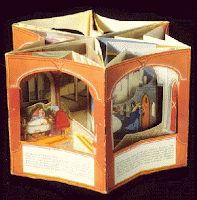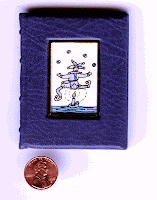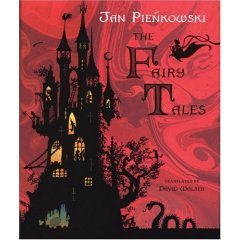New Book Roundup
I used to do these new book roundups quite a lot back when I first began this blog, but then I went through a busy period, and they fell by the wayside (geez, they take forever to do!) I've missed writing them, even though I always felt a little redundant, when there are SO many other bloggers reviewing new children's books. But eh -- it's good to partake of the ongoing dialogue about new books.
And keep in mind that when I say "new," I mean "published in the last calendar year." That's cutting-edge enough for me.
 The Last Dragon by Silvana De Mari
The Last Dragon by Silvana De Mari
The Plot: Yorsh is an orphaned elf, blessed with incredible magical powers, but finds he is the last of his kind on earth. Upon the discovery of an ancient prophecy, he goes on a quest to find the last of all dragons, and thus starts a chain of events that lead both him, the repressed people of his kingdom, and a clairvoyant girl named Robi, to freedom.
Ooooooh, I was in the middle of this book when it was awarded a Batcheleder Honor, and can I say that I did a little dance about it? There was an overwhelmingly high number of fantasy books published in 2006, and because this came out in autumn, I think a lot of people missed it.
Go out now, people. This is the one you're going to want to pass on to your grandkids. Whenever I talk about it, I start to sound like the grandpa from The Princess Bride: "It's got everything! Sword fighting, dragons, magic powers, an evil overlord, daring escapes, true love . . ." In other words, most of what we see in De Mari's world is pretty standard fare for most fantasy novels, but is rendered with highly imaginative imagery, witty turns of phrase, and a certain genuineness to the characters that it transcends cliché. De Mari writes with an emotional sincerity that touches something basic and true in the heart, which is a hallmark, I think, of the greatest stories.
Plus, it don't hurt that the hero grows up to be a hottie ("as handsome as the sun," says De Mari). I'm just sayin' is all.
 Alabama Moon by Watt Key
Alabama Moon by Watt Key
The Plot: Ten-year-old Moon is raised as a forest hermit, 19th-century frontier style by his Vietnam vet, government-hating father. When his Pap dies, his last wish is for Moon to continue their lifestyle in Alaska, but instead the state puts Moon in a boys' home. Moon makes friends at the home, escapes to the forest with them, and begins exciting nature survival/run from the law adventure. Meanwhile, Moon begins to question his father's beliefs, and creates new definitions of personal responsibility, friendship, and what it means to be part of a society.
So, if you were to take a truckload of Hatchet, sprinkle it with Holes, and crash-drive it into The Shawshank Redemption, this is probably the book you'd end up with. Watt Key has created a very rough portrait of the South in this story. This book is set WAY down deep in Dixie; I mean, this is a book wherein the local judge doesn't hesitate to lift his robes and take a whizz by the side of the road. However, this setting is tempered with Moon's gentle personality and Key's rich, fascinating descriptions of forest life and survival. (Moon makes mosquito repellent out of acorn oil! And an arrow out of squirrel bones! If he were on Gilligan's Island, he'd be the one to make the coconut transistor radio.) The plot is gripping and quick, and while I think the villain (a cop trying to catch the fugitives) is a bit of a mustache-twirler, it doesn't dampen the book's emotional impact.
I noticed this book on a few mock Newbery lists last year, but it didn't actually win an ALSC award, and do you know why I think that is? There's a long sequence in the middle of the book in which Moon and his friends use a machine gun to blow away empty beer bottles in the middle of a mudpit. There's a lot of boy-with-gun action in this book, and while I know that this is a reality for a lot of kids, there will be many adult readers who may have a problem with it (I personally thought it was a hoot, storywise).
 Vive La Paris by Esmé Raji Codell
Vive La Paris by Esmé Raji Codell
The Plot: Paris McCray, a fifth grader from inner-city Chicago, is sent to elderly Mrs. Rosen for piano lessons. The two of them form a quirky friendship, the benefits of which -- learning to see the world through rose-colored glasses -- trickle down to the other happenings in Paris' life, particularly her troubles with bullying classmate Tanaeja. When Paris learns that Mrs. Rosen is a survivor of the Holocaust, she momentarily loses her faith in humanity, viewing the world as a place where bullies always win. But with the help of friends and family, she slowly learns to be hopeful again, and learns how to truly care for others in the process.
There's a lot going on in this book -- in addition to the Holocaust and bullying, this book also touches on teen pregnancy, religious faith, racism, and much, much more. The book almost drowns in this mass of issues, but what keeps it afloat is Codell's spot-on ear for child voices, for the politics of classroom relationships, and for the ups and downs of life in a big family. Paris is spunky, smart, and fiercely loyal to her family; her fall from innocence is pretty painful to read, and just a wee bit heavy-handed, but leads to a satisfying conclusion. This book is described as a "companion" to Codell's previous novel, Sahara Special, but stands pretty firmly on its own.
My only request, Ms. Esmé: please, please give us a novel about Darrell, the renegade member of Paris' class! He rocks my world!
 Romeo's Ex: Rosaline's Story by Lisa Fiedler
Romeo's Ex: Rosaline's Story by Lisa Fiedler
The Plot: It's Romeo and Juliet as told from the perspective of several of the minor characters, principally Rosaline, the girl who rejects Romeo before the play begins. In this story, Rosaline is an apprentice healer as well as Juliet's best cousin and friend; the intelligent girl finds Romeo's advances "nauseating," but finds new affection both in Benvolio (who rescues her during the fight that begins the play) and Mercutio (who takes credit for said rescue).
Okay, okay, I try to limit my book reviews to those for readers ages 0-14, and this is pushing that upper limit, but hey! Look at that pretty, pretty cover! Who can resist that gorgeousness?
There are quite a few novelizations of Shakespeare plays for young readers out there, but I've a special fondness for Fiedler's. Not only does she give the story a decidedly feminist spin, but she has an infectious love for Elizebethan language; the text sparkles with wordplay, double meanings, and quite a few bawdy puns ("To Honor!" Mercutio toasts. "Get on her, and stay on her!"). Dialogue taken directly from the play is given new levels of meaning with the fleshing out of all the minor characters -- what was Mercutio up to during the Capulets' party? Exactly how did Rosaline dump Romeo? -- and even though Fiedler takes liberties with the plot, her characters remain characteristially Shakespearean: they fall in love, rage with fury, and experience major changes of heart almost instantaneously; the plot is peppered with bumbling, dimwitted mechanicals and a rather humbug undertaker. Several chapters are narrated by Tybalt's ghost, allowing readers to see scenes inaccessible to the other characters. Sly references to other plays are also here; the seedy tavern in Verona is named The Untamed Shrew.
While the book does require some advance familiarity with the play, the fun and drama in this book is pretty addictive; the entire time I was reading it, I kept wanting to IM my friends with dishy gossip about the characters ("OMG, Rosaline is totally crushing on Mercutio!") Pick it up, and you'll be sucked in, too. You've been warned.
Oh, and speaking of Taming of the Shrew: I'm betting it's the pick for Fiedler's next Shakespeare spin. Ooooh, I hope I'm right!










































